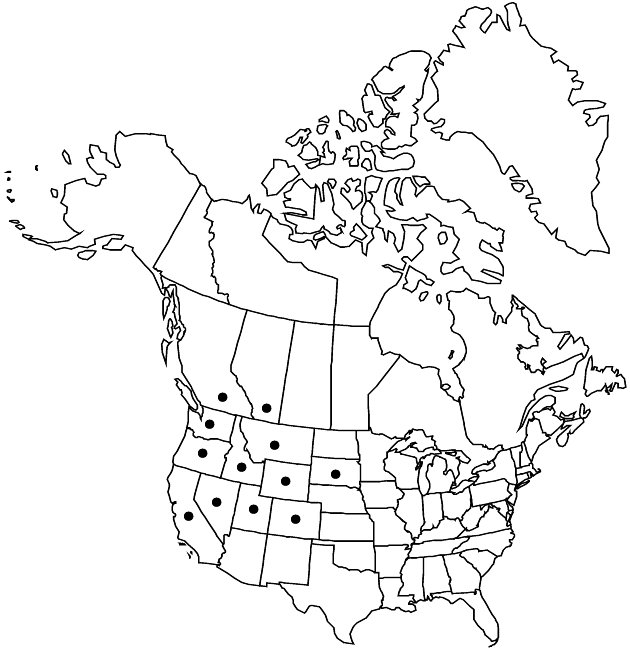Difference between revisions of "Antennaria luzuloides"
Fl. N. Amer. 2: 430. 1843.
FNA>Volume Importer |
RevisionBot (talk | contribs) m (Bot: Adding category Revised Since Print) |
||
| (8 intermediate revisions by 3 users not shown) | |||
| Line 8: | Line 8: | ||
}} | }} | ||
|common_names=Rush or silvery brown pussytoes | |common_names=Rush or silvery brown pussytoes | ||
| + | |special_status={{Treatment/ID/Special_status | ||
| + | |code=E | ||
| + | |label=Endemic | ||
| + | }} | ||
|basionyms= | |basionyms= | ||
|synonyms= | |synonyms= | ||
| Line 20: | Line 24: | ||
-->{{Treatment/Body | -->{{Treatment/Body | ||
| − | |distribution= | + | |distribution=Alta.;B.C.;Calif.;Colo.;Idaho;Mont.;Nev.;Oreg.;S.Dak.;Utah;Wash.;Wyo. |
|discussion=<p>subspecies 2 (2 in the flora)</p><!-- | |discussion=<p>subspecies 2 (2 in the flora)</p><!-- | ||
| − | --><p>Some authors have recognized Antennaria microcephala (= A. luzuloides subsp. aberrans) as a distinct species. Given the intergradation between A. luzuloides in the strict sense and A. microcephala in the strict sense, one species with two subspecies seems justified. Perhaps the most significant difference between the subspecies is ecologic. Antennaria luzuloides is a member of the Argenteae group.</p> | + | --><p>Some authors have recognized <i>Antennaria</i> microcephala (= <i>A. luzuloides </i>subsp.<i> aberrans</i>) as a distinct species. Given the intergradation between <i>A. luzuloides</i> in the strict sense and <i>A. microcephala</i> in the strict sense, one species with two subspecies seems justified. Perhaps the most significant difference between the subspecies is ecologic. <i>Antennaria luzuloides</i> is a member of the Argenteae group.</p> |
|tables= | |tables= | ||
|references= | |references= | ||
| Line 45: | Line 49: | ||
-->{{#Taxon: | -->{{#Taxon: | ||
name=Antennaria luzuloides | name=Antennaria luzuloides | ||
| − | |||
|authority=Torrey & A. Gray | |authority=Torrey & A. Gray | ||
|rank=species | |rank=species | ||
| Line 52: | Line 55: | ||
|basionyms= | |basionyms= | ||
|family=Asteraceae | |family=Asteraceae | ||
| − | |distribution= | + | |distribution=Alta.;B.C.;Calif.;Colo.;Idaho;Mont.;Nev.;Oreg.;S.Dak.;Utah;Wash.;Wyo. |
|reference=None | |reference=None | ||
|publication title=Fl. N. Amer. | |publication title=Fl. N. Amer. | ||
|publication year=1843 | |publication year=1843 | ||
| − | |special status= | + | |special status=Endemic |
| − | |source xml=https:// | + | |source xml=https://bitbucket.org/aafc-mbb/fna-data-curation/src/2e0870ddd59836b60bcf96646a41e87ea5a5943a/coarse_grained_fna_xml/V19-20-21/V19_629.xml |
|tribe=Asteraceae tribe Gnaphalieae | |tribe=Asteraceae tribe Gnaphalieae | ||
|genus=Antennaria | |genus=Antennaria | ||
| Line 63: | Line 66: | ||
}}<!-- | }}<!-- | ||
| − | -->[[Category:Treatment]][[Category:Antennaria]] | + | --> |
| + | |||
| + | [[Category:Treatment]] | ||
| + | [[Category:Antennaria]] | ||
| + | [[Category:Revised Since Print]] | ||
Latest revision as of 18:21, 6 November 2020
Dioecious. Plants 7–35(–70) cm (often viviparous in late season, bearing propagules in distal and, sometimes, proximal leaf axils, sometimes woody at bases). Stolons none. Basal leaves 1–3-nerved, linear to narrowly spatulate, 18–55 × 1–10 mm, tips acuminate, faces gray-tomentose. Cauline leaves narrowly oblanceolate to linear, 5–60 mm, flagged. Heads 10–110+ in racemiform to paniculiform or corymbiform arrays. Involucres: staminate 3.5–5.5 mm; pistillate 3.5–6.5 mm. Phyllaries (relatively narrow, proximally green or golden brown, glabrous) distally white, acute. Corollas: staminate 2.5–4 mm; pistillate 2–4 mm. Cypselae 1–2 mm, sparingly papillate or papillate-strigose (hairs clavate); pappi: staminate 3–4.5 mm; pistillate 2.5–4 mm. 2n = 28.
Distribution

Alta., B.C., Calif., Colo., Idaho, Mont., Nev., Oreg., S.Dak., Utah, Wash., Wyo.
Discussion
subspecies 2 (2 in the flora)
Some authors have recognized Antennaria microcephala (= A. luzuloides subsp. aberrans) as a distinct species. Given the intergradation between A. luzuloides in the strict sense and A. microcephala in the strict sense, one species with two subspecies seems justified. Perhaps the most significant difference between the subspecies is ecologic. Antennaria luzuloides is a member of the Argenteae group.
Selected References
None.
Key
| 1 | Heads 10–110+ in corymbiform arrays; basal leaves (1–)3-nerved; dry sagebrush-ponderosa pine com- munities | Antennaria luzuloides subsp. luzuloides |
| 1 | Heads 10–30 in racemiform to paniculiform arrays; basal leaves 1(–3)-nerved; moist meadows or along moist drainages in ponderosa pine commu- nities | Antennaria luzuloides subsp. aberrans |